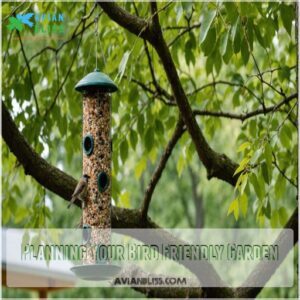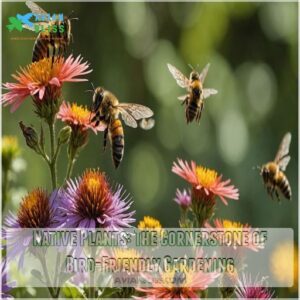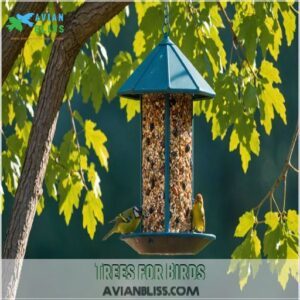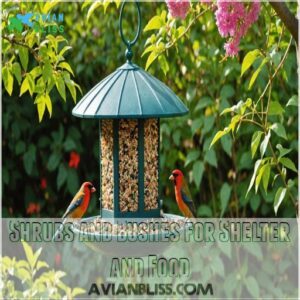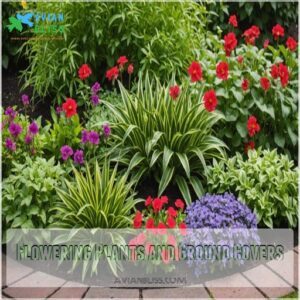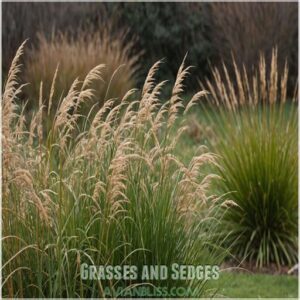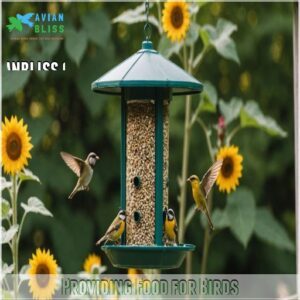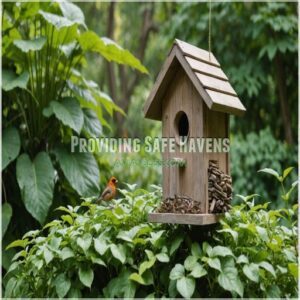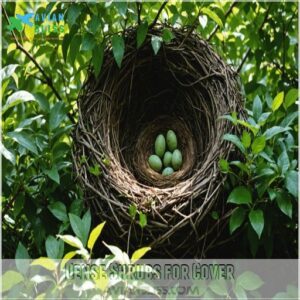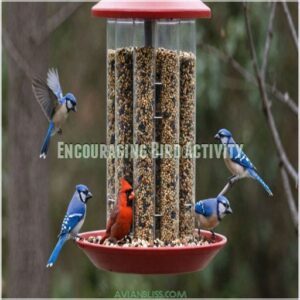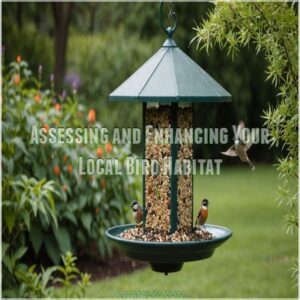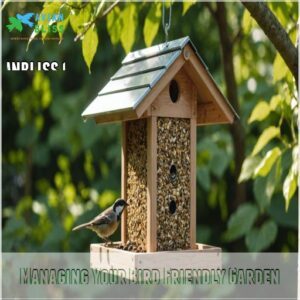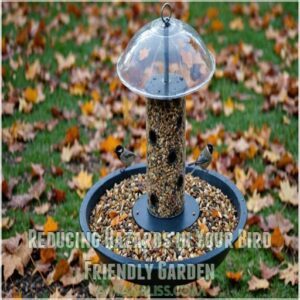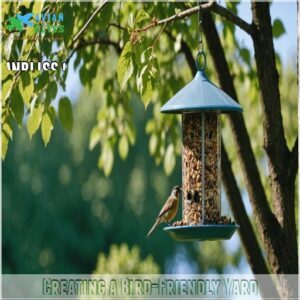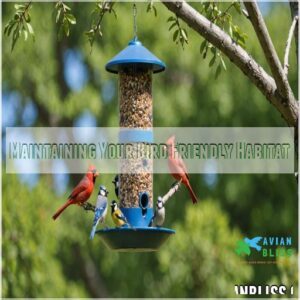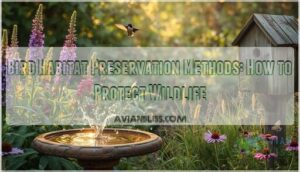This site is supported by our readers. We may earn a commission, at no cost to you, if you purchase through links.
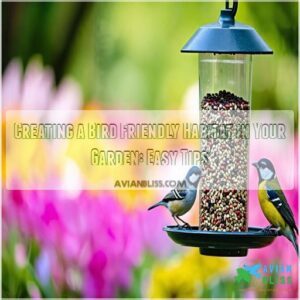
Start by planting native trees and shrubs—these are like the local hangouts for birds, providing food and shelter.
Set up bird feeders and water sources, but remember, variety is the spice of life! Different seeds will attract different species.
Don’t forget to offer nesting materials like twigs and dry grass.
Reducing pesticide use makes sure a safe haven for insects, which are a tasty treat for birds.
Finally, keep your cat indoors, sparking a birdie fiesta in your garden.
Ready for more feathery fun? Let’s dig deeper!
Table Of Contents
- Key Takeaways
- Planning Your Bird Friendly Garden
- Choosing Plants for Birds
- Providing Food for Birds
- Creating Shelter for Birds
- Encouraging Bird Activity
- Assessing and Enhancing Your Local Bird Habitat
- Managing Your Bird Friendly Garden
- Reducing Hazards in Your Bird Friendly Garden
- Creating a Bird Friendly Yard
- Maintaining Your Bird Friendly Habitat
- Frequently Asked Questions (FAQs)
- How to create a bird friendly garden?
- How do you create a bird habitat?
- Do birds help or hurt a garden?
- What is the best environment for birds?
- How do I attract migratory birds?
- What colors attract birds to my garden?
- Can I prevent squirrels from accessing feeders?
- How frequently should birdbaths be cleaned?
- Do garden lights affect bird activity?
- Conclusion
Key Takeaways
- You’ll attract more birds by planting native trees, shrubs, and flowers that provide food and shelter year-round.
- Providing a reliable water source, like a bird bath, is crucial for bird survival and will encourage more visits.
- You should reduce or eliminate pesticide use to create a safe haven for birds and the insects they eat.
- Keeping cats indoors protects birds from predation and ensures a safer environment in your garden.
Planning Your Bird Friendly Garden
When planning your bird-friendly garden, consider factors like your USDA Plant Hardiness Zone, sunlight, and soil type to select the perfect native plants.
Sketch a design that attracts birds year-round, ensuring they’ve food, shelter, and protection from invasive species—because who wants to deal with unruly garden gangsters anyway?
Know Your Space
Start by really knowing your space when planning a birdfriendly yard.
Check sunlight patterns, soil type, and your hardiness zone.
Size and terrain matter, too.
Consider sourcing native plants from online stores like plants for native birds.
For birdfriendly landscaping, think about native plants that suit your backyard.
Creating a bird-friendly habitat with native plants, such as those found in local bird habitat restoration projects near me, involves understanding these elements.
Remember, a thriving birdfriendly yard is
Plan Ahead
Planning your bird-friendly garden is like setting up an artistic masterpiece. Visualize your space and consider:
- Budgeting: Match your resources with ambition.
- Timeline: Allow room for seasonal changes.
- Tools: Make sure you have spades, hoes, and more.
- Resources: Gather knowledge and supplies.
- Location: Pick sunny spots for thriving habitats.
A well-thought layout invites diverse bird species.
Grow Native Plants
Thinking about enhancing your garden’s vibe?
Opt for native plants—they’re a win-win for you and your feathered friends.
With strategic native plant selection, you’ll offer essential food and shelter.
Check local nurseries for seed sourcing, avoiding invasive species.
These bird friendly plants don’t just thrive; they create a delightful wildlife habitat, making bird species flock joyfully to your yard.
Create a Four-Season Garden
Imagine your garden bustling with life all year round.
By embracing seasonal planting and crafting a flowering calendar, you offer birds and pollinators a year-long feast.
Include bird-friendly fruit trees and native plants to provide reliable food sources, enriching your bird habitat creation.
Just picture the joy when your garden becomes a true four-season oasis, alive with nature’s symphony.
Watch Out for Invasives
Now that you’ve planned your four-season garden, let’s tackle invasive plants.
They’re garden bullies, hogging resources and harming bird species.
Learn invasive plant identification; your local garden center can help.
Replacing them with native alternatives supports bird habitat creation.
Proper invasive plant removal follows local regulations.
It’s a win-win for birds and your birdfriendly gardening efforts!
Choosing Plants for Birds
When you’re picking plants for your garden, native species are your best bet because they naturally support local birds and insects.
Oaks, pines, and viburnum can attract many types of birds, including those found in New Mexico’s diverse habitats like backyard birds of New Mexico, which can turn your yard into a feathered friend’s paradise, making every day a delight.
Native Plants: The Cornerstone of Bird-Friendly Gardening
Let’s fine-tune your bird-friendly garden with native plants, nature’s own blueprint for bird-friendly habitats.
They offer endless native plant benefits and minimize invasive species.
Here’s a quick guide to get started:
- Plant Identification: Know your local flora.
- Seed Sourcing: Visit local nurseries for authentic supplies.
- Wild Guests: Attract diverse bird species.
- Eco Harmony: Boost bird-friendly gardening naturally.
Trees for Birds
Choosing birdfriendly trees transforms your yard into a bustling bird habitat.
Consider Oak Trees for a feast of caterpillars essential for bird nesting.
Pine Trees offer cozy bird nesting sites with their protective cones.
Fruiting Trees add a sweet touch, attracting diverse bird species with their delightful bounty.
| Tree Type | Benefits | Bird Species Attracted. To create an inviting space, consider the types of local bird species lists that visit your area |
|---|---|---|
| Oak Trees | Insect-rich diet | Warblers, Vireos |
| Pine Trees | Safe nesting sites | Chickadees, Nuthatches |
| Fruiting Trees | Nutritious fruits | Robins, Thrushes |
Shrubs and Bushes for Shelter and Food
Think about shrubs when you’re aiming to attract birds, as they offer shelter and food.
Native berry-bearing bushes like viburnum provide winter food sources, drawing specific birds to your garden.
Shrub selection is key—opt for those that double as nesting sites and bird-friendly shelter.
You’ll find these avian visitors truly appreciate the cozy hideaways these shrubs offer.
Flowering Plants and Ground Covers
Imagine sipping coffee while hummingbirds zip around vibrant blooms!
Opt for pollinator-friendly varieties like native coneflowers or bee balm.
Native plants and birdfriendly flowers attract birds but also offer drought-tolerant options.
Ground covers like creeping thyme keep pesky invasives at bay, contributing to a harmonious bird friendly habitat while adding beauty and resilience to your garden.
Grasses and Sedges
Ever notice how grasses, sedges, and rushes can transform your garden into a bird paradise?
These plants offer seed heads and winter interest while boosting habitat value.
Try adding native types for a bird-friendly habitat.
Here’s how:
- Enhances cover for birds
- Provides nesting materials
- Attracts insects for food
- Supports bird conservation
- Adds aesthetic appeal
Providing Food for Birds
Providing a reliable food source is key to attracting birds to your garden.
You can achieve this by planting native trees, shrubs, and flowers that offer seeds, berries, and insects throughout the year.
Supplementing with bird feeders when necessary.
Natural Food Sources
After choosing the right bird-friendly plants, focus on natural food sources.
Native plants, bursting with insect diversity, are the buffet birds crave.
Consider adding berry-producing shrubs for delightful seasonal variation.
Seed-bearing grasses provide yet another tasty treat for many bird species.
You’re creating a paradise where birds feel at home, finding plenty of healthy, natural bird food.
Supplemental Feeding: Bird Feeders
Feeding backyard birds can be like opening a delightful restaurant right in your garden.
Consider different types of feeders to cater to your feathered friends’ tastes.
Clean your bird feeders regularly to prevent germs.
Remember, placement matters—pick spots that are safe yet visible.
Homemade feeders can add a personal touch, making bird feeding both a fun and rewarding hobby.
Choosing Bird Seed
Selecting the right bird seed can feel like choosing from a menu designed for backyard birds.
Each seed mix or type attracts different bird species.
Keep seeds fresh by storing them properly, and be mindful of seed cost.
Keep an eye out for:
- Sunflower seeds for cardinals and finches
- Millet for sparrows
- Nyjer for finches
- Suet cakes for woodpeckers
Creating Shelter for Birds
Creating shelter for birds in your garden involves planting dense shrubs and offering nesting sites to provide safe havens from predators.
By doing so, you’ll protect your feathered friends and gain some delightful garden companions who may sing in the early morning.
Providing Safe Havens
Why not turn your garden into a bird sanctuary?
Provide dense vegetation or brush piles as natural shelters, giving birds a cozy spot to escape predators and bad weather.
Add birdhouses and bird baths to create a welcoming haven.
These safe havens offer the perfect retreat, allowing your feathered friends to thrive, adding beauty and life to your space.
Nesting Sites
Craft a welcoming haven by setting up birdhouses that mirror natural nest cavities.
Consider using birdhouses for small birds made from untreated wood like cedar for durability and safety, as well as following specific design guidelines birdhouses for small birds.
Your DIY efforts can boost bird species diversity with thoughtful birdhouse design and perfect nest box placement.
Protect nests from pesky predators, using durable materials to meet nesting material needs.
Dense Shrubs for Cover
Several dense shrubs offer superb bird shelter.
Think of them as tiny, leafy fortresses against predators!
Shrub selection is key for predator protection; evergreens provide vital winter cover.
Planting a variety guarantees habitat diversity, attracting various bird species.
These birdfriendly shrubs become safe nesting sites, boosting bird diversity in your garden.
Remember, a happy bird is a singing bird!
Encouraging Bird Activity
To encourage bird activity in your garden, create a diverse environment with a variety of plants and structures that meet their needs.
Reduce hazards like reflective windows and provide fresh water sources to keep your avian visitors safe and happy.
Creating a Diverse Environment
Imagine a garden buzzing with bird chatter—thanks to a diverse environment you’ve created.
Mix native plants of varying heights to boost bird diversity.
Different seasons bring unique blooms, ensuring year-round interest and shelter.
Your garden design becomes a vibrant habitat structure, offering bird-friendly plants as food sources.
It’s like hosting a bird potluck with seasonal variation as the secret ingredient!
Reducing Hazards
Think about attracting a variety of birds to your garden by reducing hazards.
Use decals on windows to minimize strikes, and keep cats indoors for bird safety.
Reduce pesticide use to prevent chemical dangers.
Maintain habitat diversity by protecting birdhouses from predators.
With these bird conservation tips, your garden becomes a wildlife sanctuary, inviting feathered friends safely to stay.
Providing Water Sources
After tackling the hazards, let’s splash into the fun part: providing water sources.
A charming bird bath or trickling water feature adds flair to your birdfriendly garden.
Make sure water quality by cleaning regularly and keeping water depth to a safe level.
Strategically locate bird water for all-day access, boosting your bird habitat gardening with joyful winged visitors.
Assessing and Enhancing Your Local Bird Habitat
To create a welcoming space for birds, start by evaluating your local environment and identifying what it already offers.
Planting trees and including plants with year-round fruit and flowers, you’ll transform your garden into a bird paradise.
Assess The Bird Habitat in Your Local Area
When you’re keen to welcome more feathered friends, take a moment to assess your local bird habitat.
Consider installing bird nesting solutions to address limited nesting success.
Observe which local bird species frequent your area, and where bird feeder placement might encourage visits.
Spot habitat challenges like limited nesting success or scarce bird food sources.
Investing time in birdwatching reveals the impact of native plants
Look for Year-Round Fruit and Flowers
Now that you’ve assessed your garden, let’s talk year-round food sources!
Birds need to eat all year long, not just in summer.
To help them out, consider these birdfriendly plants offering year-round flowers and fruit:
- Hollies provide winter berries.
- Coneflowers offer seeds in the fall.
- Certain viburnums boast berries all year.
These edible landscaping choices also offer pollinator benefits!
Plant a Tree
Finding year-round fruits and flowers leads us to planting a tree, a smart move for any bird-friendly landscape design.
Consider tree selection by focusing on local species that provide food and shelter, such as those that attract birds with native shrubs and trees.
Learn planting techniques ensuring proper tree care.
Native trees attract various bird species but also support bird-friendly plants, promoting a thriving,
Build a Log Pile
Planting a tree is just the start.
Add a log pile for endless wonders.
This heap of decomposing wood creates an insect hub, inviting birds to feast.
It doubles as a wildlife shelter and offers nesting materials.
You’ll support wildlife conservation effortlessly, enhancing your backyard bird habitat.
Imagine your garden as a bustling wildlife metropolis, teeming with life.
Managing Your Bird Friendly Garden
Managing your bird-friendly garden doesn’t have to feel like a chore; it’s about embracing seasonal rhythms and enjoying the feathery friends you attract.
By leaving some leaves and brush around, you’ll provide natural shelter and nourishment, letting your garden offer year-round hospitality to visiting birds.
Seasonal Care
Embrace the rhythm of nature in your bird-friendly garden!
Jump into spring cleanup with gusto, ensuring your garden is ready for summer feeding and native plant gardening.
Fall planting sets the stage for vibrant winter protection, keeping your feathered friends cozy.
With these bird-friendly landscaping ideas, you’ll master seasonal care, making your garden a wildlife haven all year round.
Observing and Enjoying Your Birds
Watching your feathered friends adds joy to your garden.
Birds bring life and surprises to your days as they flit and frolic.
Enhance your experience with:
- Birdwatching tips: Keep a field guide handy for quick bird ID.
- Backyard bird ID: Use binoculars for close-up views.
- Bird sounds: Listen for unique calls.
- Bird photography: Capture their antics!
Leave Some Leaves (and Brush)
Consider leaving a bit of leaf litter and brush in your garden.
It’s not just a mess; it’s a buffet for birds!
These natural elements offer essential shelter and food sources, supporting winter bird cover and natural habitat like native plants and bird baths.
Creating a bird-friendly yard requires embracing these garden cleanup alternatives, and watch your bird-friendly landscape design become a lively, unexpected wildlife gardening masterpiece.
Take Care of Your Garden
Leaving leaves helps, but garden maintenance is key!
Regular weeding keeps your bird-friendly haven healthy.
Healthy soil means happy plants, attracting more birds.
Practice smart pest management; avoid harsh chemicals.
Use gentle pruning techniques to keep plants thriving.
It’s all about organic gardening for a flourishing wildlife garden.
Remember, a little care goes a long way in bird conservation.
Reducing Hazards in Your Bird Friendly Garden
To create a bird-friendly garden, you need to reduce hazards like pesticides and make sure birdhouses are safe and secure.
Imagine birds enjoying a pesticide-free buffet and splashing in fresh water, adding energy and songs to your space.
Reduce Pesticide Use
Swapping pesticides for organic gardening solutions keeps your feathered pals safe while promoting birdfriendly practices.
Embrace beneficial insects as natural allies against pests, boosting pollinator health and ensuring vibrant wildlife-friendly gardening.
Choose chemical alternatives like neem oil or soap sprays, which protect bird conservation efforts without sacrificing your garden’s beauty.
Keep your winged visitors soaring safely through pesticide reduction tips.
Put Out a Buffet for Birds
Imagine offering a feast that makes birds flock to your garden like it’s their favorite diner.
By setting up bird-friendly feeders with assorted bird seed mixes, you’ll attract a colorful array of birds.
DIY bird food options add a personal touch.
Strategic feeder placement keeps the avian party thriving.
With these birdfriendly gardening tips, you’re the ultimate host!
Check Your Birdhouses
While putting out a buffet for birds, remember to check your birdhouses.
Regular cleaning and maintenance help avoid unwanted guests and guarantee safety.
Placement matters; hang them at the right height to keep birds cozy and safe.
Size and specific designs cater to different species, enhancing your bird-friendly habitat.
Tweak these features for a thriving backyard bird habitat.
Offer Birds a Source of Fresh Water
Checking birdhouses for wear isn’t your only task.
Birds also need fresh water, unlike the kids who’d rather pop open a soda.
To attract more feathered friends, consider these:
- Bird Bath Types: Choose between hanging or pedestal.
- Water Features: Fountains add charm.
- Water Quality: Clean regularly.
Creating a bird-friendly landscape keeps them chirping happily!
Creating a Bird Friendly Yard
Transforming your yard into a bird haven starts with ditching the grass and diversifying your landscape with native trees and shrubs.
Remember, insects don’t make great seasoning, so skip the bug sprays and let nature’s tiny friends do their thing.
Say Goodbye to Grass
Many find endless lawn mowing a chore.
Consider replacing your lawn with native plants!
This simple swap dramatically boosts your backyard bird habitat.
Explore Lawns vs. Natives; you’ll discover amazing Bird-Friendly Alternatives.
Ground Cover Options offer beauty and benefits.
Maintaining a Diverse Landscape is key for attracting birds.
Enjoy the Benefits of No-Mow Yards—more time for birdwatching!
Create Structure
Imagine your backyard as a bustling apartment complex for birds, with vertical layers acting as individual floors.
By varying plant heights, you create habitat diversity that’s the bird equivalent of room service.
Add ground cover and strategic shrub placement to enhance your birdfriendly landscape design.
These birdfriendly landscaping ideas transform your backyard into a welcoming birdfriendly habitat, offering safety and comfort.
Use Trees and Shrubs
Choosing the right trees and shrubs is like setting the stage for a bird-friendly habitat.
Incorporating species like oak, hazelnut, and holly trees can attract blue jays.
Opt for native species to attract local birds while offering perching and nesting spaces.
A mix of shade and sun-loving plants enhances diversity, while bird-friendly pruning helps growth remain inviting.
Add year-round interest with species that boast vibrant
Don’t Spray Insecticides
Picture a vibrant garden teeming with life, where birds flutter freely without the shadow of harmful chemicals.
Opt for organic gardening and embrace chemical alternatives to protect bird health.
The pesticide impact on wildlife is no joke—choosing bird-friendly gardening practices supports bird conservation tips and guarantees a safe garden for wildlife.
Let your garden’s buzz be all-natural!
Maintaining Your Bird Friendly Habitat
To keep your bird-friendly garden thriving, make sure to provide a variety of foods, secure nesting spaces, and fresh water.
Remember to keep your feline friends indoors to guarantee a safe haven for visiting birds.
Create a Multi-species Buffet
Every morning, craft a multi-species buffet in your garden to delight diverse bird visitors.
To attract a variety of bird species, make sure you’re not using cheap bird feed choices.
Offer bird-friendly plants with seed diversity, strategically place feeders to maximize bird watching, and attract hummingbirds with nectar-rich flowers.
Keep the balance in your backyard bird habitat by managing pests naturally.
This approach
Add a Birdhouse
Thinking of adding a birdhouse to your garden? Start with proper birdhouse placement to attract your favorite bird species.
Consider these tips:
- Choose the right nest box types.
- Regularly check for birdhouse maintenance.
- Try DIY birdhouses for a personal touch.
- Pick a spot with low human traffic.
- Make sure it’s protected from predators.
By incorporating native plants, bird feeders, and bird baths, you can create a haven for birds, similar to bird-friendly environments. This simple addition transforms your garden into a welcoming backyard bird habitat!
Offer a Water Source
A birdbath is a simple yet important addition to your bird habitat.
You can find a variety of birdbath products online at birdbath shopping.
Choose a shallow dish; birds prefer shallow water for bathing.
Place it in a sunny spot, away from bushes where cats might hide.
Keep the water clean and fresh; regularly change it to prevent disease.
This simple act
Keep Cats Indoors
You’ve set up a delightful bird bath, and now let’s protect those birds! Keeping your cats indoors preserves bird safety and lets your garden’s wildlife flourish.
Pamper your feline with enriching activities to keep their instincts satisfied indoors.
- Create an indoor jungle gym.
- Introduce puzzle feeders.
- Set up window perches for bird watching.
- Engage in regular play sessions.
- Consider catios for safe outdoor time.
Frequently Asked Questions (FAQs)
How to create a bird friendly garden?
A bird-friendly garden is a buffet for feathered friends.
Plant native shrubs, trees, and flowers for food and shelter.
Provide water, avoid pesticides, and let some areas grow wild.
Your yard will soon be a bird paradise!
How do you create a bird habitat?
Plant diverse native plants for year-round food and shelter.
Provide a water source.
Create safe nesting spots with shrubs and birdhouses.
Plant native plants with seed-bearing flowers and berry-bearing trees around these areas to provide natural food sources, including sunflowers and holly, and keep some areas wild to naturally attract birds and support their needs.
Do birds help or hurt a garden?
Imagine birds as nature’s cleanup crew, swooping in to munch on pesky insects.
While they sometimes nibble your fruits, their pest control and vibrant presence usually outweigh any munching mishaps.
Let nature’s orchestra play in your garden!
What is the best environment for birds?
Birds thrive in diverse habitats with native plants providing food and shelter.
They need consistent food sources, clean water, and safe nesting sites.
Think varied plant heights, dense shrubs, and maybe a birdhouse!
How do I attract migratory birds?
To attract migratory birds, offer a variety of native plants for food, like berries and seeds.
Provide fresh water sources for drinking and bathing.
Make sure to provide safe shelters, reducing threats like predators or window collisions.
What colors attract birds to my garden?
Colors like red, orange, and yellow mimic nature’s vibrant cues, beckoning birds to your garden.
These hues, reminiscent of flowers and fruits, catch their eye, making them feel welcome and keen to visit your vibrant paradise.
Can I prevent squirrels from accessing feeders?
You can outsmart pesky squirrels at your feeder by installing a baffle or using a squirrel-proof design.
Hang feeders away from jumping-off points, like trees or fences.
Consider spicy birdseed, which birds love but squirrels hate!
How frequently should birdbaths be cleaned?
Picture serene feathered friends enjoying a clean oasis.
Clean birdbaths every two to four days.
Regular maintenance prevents algae, mosquitoes, and germs, ensuring a fresh retreat.
A clean bath keeps birds happy and visiting often, especially when it’s a shallow basin with a mister for hot weather. A clean bath keeps birds happy and visiting often.
Do garden lights affect bird activity?
Bright garden lights can disrupt bird activities, altering their natural behaviors like feeding and resting.
Motion-activated lights can minimize disturbance, helping guarantee the local birds remain stress-free and active in their habitat.
Consider using softer, motion-activated lights to minimize disturbance, helping guarantee the local birds remain stress-free and active in their habitat.
Conclusion
Isn’t it ironic? All that effort to create a bird-friendly habitat and you’re the one watching your garden take flight.
By planting native species, ditching pesticides, and setting up feeders, you’ve turned your yard into a bird sanctuary.
You get the joy of watching diverse bird species, but your garden flourishes too.
Keep your cats inside, and remember, this tiny ecosystem thrives under your care and attention.
Happy birdwatching in your vibrant garden!

